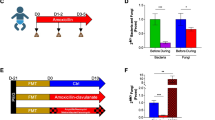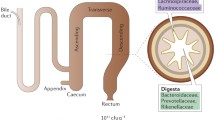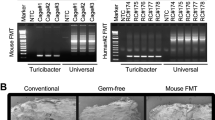Abstract
We tested two hypotheses concerning the dynamics of intestinal microbial communities of young mice following antibiotic-induced disturbance. The first is that disturbance of the bacterial community causes disturbance of the fungal community. Our results were consistent with that hypothesis. Antibiotics significantly altered bacterial community structure. Antibiotics also altered fungal community structure, significantly increasing the relative abundance of Candida lusitaniae, a known pathogen, while simultaneously significantly decreasing the relative abundances of several other common fungal species. The result was a temporary decrease in fungal diversity. Moreover, bacterial load was negatively correlated with the relative abundances of Candida lusitaniae and Candida parapsilosis, while it was positively correlated with the relative abundances of many other fungal species. Our second hypothesis is that control mice serve as a source of probiotics capable of invading intestines of mice with disturbed microbial communities and restoring pre-antibiotic bacterial and fungal communities. However, we found that control mice did not restore disturbed microbial communities. Instead, mice with disturbed microbial communities induced disturbance in control mice, consistent with the hypothesis that antibiotic-induced disturbance represents an alternate stable state that is easier to achieve than to correct. Our results indicate the occurrence of significant interactions among intestinal bacteria and fungi and suggest that the stimulation of certain bacterial groups may potentially be useful in countering the dominance of fungal pathogens such as Candida spp. However, the stability of disturbed microbial communities could complicate recovery.








Similar content being viewed by others
Data Availability
Illumina sequence data are deposited in the NCBI Sequence Read Archive (Bioproject Accession PRJNA633842).
References
Jones RM, Luo L, Ardita CS et al (2013) Symbiotic lactobacilli stimulate gut epithelial proliferation via Nox-mediated generation of reactive oxygen species. EMBO J 32:3017–3028. https://doi.org/10.1038/emboj.2013.224
Liou A, Paziuk M, Luevano J-MJ et al (2013) Conserved shifts in the gut microbiota due to gastric bypass reduce host weight and adiposity. Sci Med 5:1–23. https://doi.org/10.1037/a0032811.Child
Rogers GB (2015) Germs and joints: the contribution of the human microbiome to rheumatoid arthritis. Nat Med 21:839–841. https://doi.org/10.1038/nm.3916
Zhang X, Zhang D, Jia H et al (2015) The oral and gut microbiomes are perturbed in rheumatoid arthritis and partly normalized after treatment. Nat Med 21:895–905. https://doi.org/10.1038/nm.3914
Alkanani AK, Hara N, Gottlieb PA et al (2015) Alterations in intestinal microbiota correlate with susceptibility to type 1 diabetes. Diabetes 64:3510–3520. https://doi.org/10.2337/db14-1847
Burrows MP, Volchkov P, Kobayashi KS et al (2015) Microbiota regulates type 1 diabetes through Toll-like receptors. Proc Natl Acad Sci U S A 112:9973–9977. https://doi.org/10.1073/pnas.1508740112
Becker C, Neurath MF, Wirtz S (2015) The intestinal microbiota in inflammatory bowel disease. ILAR J 56:192–204. https://doi.org/10.1093/ilar/ilv030
Schaubeck M, Haller D (2015) Reciprocal interaction of diet and microbiome in inflammatory bowel diseases. Curr Opin Gastroenterol 31:464–470
Dzutsev A, Goldszmid RS, Viaud S et al (2015) The role of the microbiota in inflammation, carcinogenesis, and cancer therapy. Eur J Immunol 45:17–31. https://doi.org/10.1002/eji.201444972
Paul B, Barnes S, Demark-Wahnefried W et al (2015) Influences of diet and the gut microbiome on epigenetic modulation in cancer and other diseases. Clin Epigenetics 7:1–11. https://doi.org/10.1186/s13148-015-0144-7
Ghaisas S, Maher J, Kanthasamy A (2016) Gut microbiome in health and disease: linking the microbiome-gut-brain axis and environmental factors in the pathogenesis of systemic and neurodegenerative diseases. Pharmacol Ther 158:52–62. https://doi.org/10.1016/j.pharmthera.2015.11.012
Haq RA, Schlachetzki JCM, Glass CK, Mazmanian SK (2018) Microbiome–microglia connections via the gut–brain axis. J Exp Med 216:41–59
Rojo D, Méndez-García C, Raczkowska BA et al (2017) Exploring the human microbiome from multiple perspectives: factors altering its composition and function. FEMS Microbiol Rev 41:453–478. https://doi.org/10.1093/femsre/fuw046
Hoffmann C, Dollive S, Grunberg S et al (2013) Archaea and fungi of the human gut microbiome: correlations with diet and bacterial residents. PLoS One 8:e66019. https://doi.org/10.1371/journal.pone.0066019
Ott SJ, Kuhbacher T, Musfeldt M et al (2008) Fungi and inflammatory bowel diseases: alterations of composition and diversity. Scand J Gastroenterol 43:831–841. https://doi.org/10.1080/00365520801935434
Petersen C, Round JL (2014) Defining dysbiosis and its influence on host immunity and disease. Cell Microbiol 16:1024–1033. https://doi.org/10.1111/cmi.12308
Schulfer A, Blaser MJ (2015) Risks of antibiotic exposures early in life on the developing microbiome. PLoS Pathog 11:1–6. https://doi.org/10.1371/journal.ppat.1004903
Jakobsson HE, Jernberg C, Andersson AF, et al (2010) Short-term antibiotic treatment has differing long-term impacts on the human throat and gut microbiome. PLoS One 5: . doi: https://doi.org/10.1371/journal.pone.0009836
Dollive S, Chen Y-Y, Grunberg S et al (2013) Fungi of the murine gut: episodic variation and proliferation during antibiotic treatment. PLoS One 8:e71806. https://doi.org/10.1371/journal.pone.0071806
Cho I, Yamanishi S, Cox L et al (2012) Antibiotics in early life alter the murine colonic microbiome and adiposity. Nature 488:621–626. https://doi.org/10.1038/nature11400
Huseyin CE, O’Toole PW, Cotter PD, Scanlan PD (2017) Forgotten fungi-the gut mycobiome in human health and disease. FEMS Microbiol Rev 41:479–511. https://doi.org/10.1093/femsre/fuw047
Hoarau G, Mukherjee PK, Gower-Rousseau C et al (2016) Bacteriome and mycobiome interactions underscore microbial dysbiosis in familial Crohn’s disease. MBio 7:1–11. https://doi.org/10.1128/mBio.01250-16
Grandview Research (2019) Antibiotics market size, share & trends analysis report by action mechanism (protein, DNA, RNA, cell wall synthesis inhibitors), by drug class (penicillin, cephalosporins, fluoroquinolones), and segment forecasts, 2019-2026. Grandview Research, Inc., San Francisco, California, USA.
Mukherjee PK, Chandra J, Retuerto M et al (2014) Oral mycobiome analysis of HIV-infected patients: identification of Pichia as an antagonist of opportunistic fungi. PLoS Pathog:10. https://doi.org/10.1371/journal.ppat.1003996
ten Oever J, Netea MG (2014) The bacteriome-mycobiome interaction and antifungal host defense. Eur J Immunol 44:3182–3191. https://doi.org/10.1002/eji.201344405
Suhr MJ, Hallen-Adams HE (2015) The human gut mycobiome: pitfalls and potentials - a mycologist’s perspective. Mycologia 107:1057–1073. https://doi.org/10.3852/15-147
Witherden EA, Shoaie S, Hall RA, Moyes DL (2017) The human mucosal mycobiome and fungal community interactions. J Fungi 3:56. https://doi.org/10.3390/jof3040056
Li Q, Wang C, Tang C, et al (2014) Dysbiosis of gut fungal microbiota is associated with mucosal inflammation in crohn’s disease. J Clin Gastroenterol 48:513–523 . doi: https://doi.org/10.1097/MCG.0000000000000035
Hill DA, Hoffmann C, Abt MC et al (2010) Metagenomic analyses reveal antibiotic-induced temporal and spatial changes in intestinal microbiota with associated alterations in immune cell homeostasis. Mucosal Immunol 3:148–158. https://doi.org/10.1038/mi.2009.132
Hu X, Wang T, Liang S et al (2015) Antibiotic-induced imbalances in gut microbiota aggravates cholesterol accumulation and liver injuries in rats fed a high-cholesterol diet. Appl Microbiol Biotechnol 99:9111–9122. https://doi.org/10.1007/s00253-015-6753-4
Ebino KY, Yoshinaga K, Saito TR (1988) A simple method for prevention of coprophagy in the mouse. Lab Anim 22:1–4. https://doi.org/10.1258/002367788780746548
Levine JM, D’Antonio CM (1999) Elton revisited: a review of evidence linking diversity and invasibility. Oikos 87:15–26
Turnbaugh PJ, Ridaura VK, Faith JJ et al (2009) The effect of diet on the human gut microbiome: a metagenomic analysis in humanized gnotobiotic mice. Sci Transl Med 1:6ra14. https://doi.org/10.1126/scitranslmed.3000322
David LA, Maurice CF, Carmody RN et al (2014) Diet rapidly and reproducibly alters the human gut microbiome. Nature 505:559–563. https://doi.org/10.1038/nature12820
Singh RK, Chang HW, Yan D et al (2017) Influence of diet on the gut microbiome and implications for human health. J Transl Med 15:1–17. https://doi.org/10.1186/s12967-017-1175-y
Sonnenburg E, Sonnenburg J (2014) Starving our microbial self: the deleterious consequences of a diet deficient in microbiota-accessible carbohydrates. Cell Metab 20:779–786. https://doi.org/10.1016/j.physbeh.2017.03.040
Granfeldt YE, Drews AW, Björck IME (1993) Starch bioavailability in arepas made from ordinary or high amylose corn: concentration adn gastrointestinal fate of resistant starch in rats. J Nutr 123:1676–1684. https://doi.org/10.1093/jn/123.10.1676
Lloyd-Price J, Abu-Ali G, Huttenhower C (2016) The healthy human microbiome. Genome Med 8:1–11. https://doi.org/10.1186/s13073-016-0307-y
Koide RT, Xu B, Sharda J et al (2005) Evidence of species interactions within an ectomycorrhizal fungal community. New Phytol 165:305–316. https://doi.org/10.1111/j.1469-8137.2004.01216.x
Szink I, Davis E, Ricks KD, Koide R (2016) New evidence for broad trophic status of leaf endophytic fungi of Quercus gambelii. Fungal Ecol 22:2–9. https://doi.org/10.1016/j.bmcl.2008.01.042
Hiscox J, Savoury M, Müller CT et al (2015) Priority effects during fungal community establishment in beech wood. ISME J 9:2246–2260. https://doi.org/10.1038/ismej.2015.38
Angebault C, Ghozlane A, Volant S et al (2018) Combined bacterial and fungal intestinal microbiota analyses: impact of storage conditions and DNA extraction protocols. PLoS One:13. https://doi.org/10.1371/journal.pone.0201174
Videnska P, Smerkova K, Zwinsova B et al (2019) Stool sampling and DNA isolation kits affect DNA quality and bacterial composition following 16S rRNA gene sequencing using MiSeq Illumina platform. Sci Rep 9:1–14. https://doi.org/10.1038/s41598-019-49520-3
Caporaso JG, Lauber CL, Walters WA et al (2011) Global patterns of 16S rRNA diversity at a depth of millions of sequences per sample. Proc Natl Acad Sci U S A 108:4516–4522. https://doi.org/10.1073/pnas.1000080107
Magoč T, Salzberg SL (2011) FLASH: fast length adjustment of short reads to improve genome assemblies. Bioinformatics 27:2957–2963. https://doi.org/10.1093/bioinformatics/btr507
Taylor D, Walters W, Lennon N et al (2016) Accurate estimation of fungal diversity and abundance through improved lineage-specific primers optimized for Illumina amplicon sequencing. Appl Environ Microbiol 82:7217–7226. https://doi.org/10.1128/AEM.02576-16.Editor
Callahan BJ, McMurdie PJ, Rosen MJ et al (2016) DADA2: high-resolution sample inference from Illumina amplicon data. Nat Methods 13:581–583. https://doi.org/10.1038/nmeth.3869
Edgar RC (2010) Search and clustering orders of magnitude faster than BLAST. Bioinformatics 26:2460–2461. https://doi.org/10.1093/bioinformatics/btq461
Cai L, Ye L, Tong AHY et al (2013) Biased diversity metrics revealed by bacterial 16S pyrotags derived from different primer sets. PLoS One 8:1–11. https://doi.org/10.1371/journal.pone.0053649
DeSantis TZ, Hugenholtz P, Larsen N et al (2006) Greengenes, a chimera-checked 16S rRNA gene database and workbench compatible with ARB. Appl Environ Microbiol 72:5069–5072. https://doi.org/10.1128/AEM.03006-05
Abarenkov K, Henrik Nilsson R, Larsson KH et al (2010) The UNITE database for molecular identification of fungi-recent updates and future perspectives. New Phytol 186:281–285. https://doi.org/10.1111/j.1469-8137.2009.03160.x
Anderson MJ (2001) A new method for non-parametric multivariate analysis of variance. Austral Ecol 26:32–46
R Core Team (2013) R: a language and environment for statistical computing
Oksanen JF, Blanchet G, Friendly M, et al (2018) vegan: community ecology package. https://github.com/vegandevs/vegan
Pielou EC (1966) The measurement of diversity in different types of biological collections. J Theor Biol 13:131–144. https://doi.org/10.1016/0022-5193(66)90013-0
Jost L (2006) Entropy and diversity. Oikos 113:363–375. https://doi.org/10.1111/j.2006.0030-1299.14714.x
Love MI, Huber W, Anders S (2014) Moderated estimation of fold change and dispersion for RNA-seq data with DESeq2. Genome Biol 15:1–21. https://doi.org/10.1186/s13059-014-0550-8
Rivera-Pinto J, Egozcue JJ, Pawlowsky-Glahn V et al (2018) Balances: a new perspective for microbiome analysis. mSystems 3:1–12. https://doi.org/10.1128/msystems.00053-18
Benjamini Y, Hochberg Y (1995) Controlling the false discovery rate: a practical and powerful approach to multiple testing. J R Stat Soc B 57:289–300. https://doi.org/10.2307/2346101
Fiedorová K, Radvanský M, Němcová E et al (2019) The impact of DNA extraction methods on stool bacterial and fungal microbiota community recovery. Front Physiol 10:1–11. https://doi.org/10.3389/fmicb.2019.00821
Barna C, Williams DH (1984) The structure and mode of action of glycopeptide antibiotics of the vancomycin group. Annu Rev Microbiol 38:339–357
Hancock REW, Bell A (1989) Antibiotic uptake into gram-negative bacteria. Curr Top Infect Dis Clin Microbiol 2:21–28. https://doi.org/10.1007/BF01975036
Drawz SM, Bonomo RA (2010) Three decades of β-lactamase inhibitors. Clin Microbiol Rev 23:160–201. https://doi.org/10.1128/CMR.00037-09
Jutila HM, Grace JB (2002) Effects of disturbance on germination and seedling establishment in a coastal prairie grassland: a test of the competitive release hypothesis. J Ecol 90:291–302. https://doi.org/10.1046/j.1365-2745.2001.00665.x
Mason KL, Downward JRE, Falkowski NR et al (2012) Interplay between the gastric bacterial microbiota and Candida albicans during postantibiotic recolonization and gastritis. Infect Immun 80:150–158. https://doi.org/10.1128/IAI.05162-11
Hogan DA, Vik Å, Kolter R (2004) A Pseudomonas aeruginosa quorum-sensing molecule influences Candida albicans morphology. Mol Microbiol 54:1212–1223. https://doi.org/10.1111/j.1365-2958.2004.04349.x
Noverr MC, Falkowski NR, Mcdonald RA et al (2005) Development of allergic airway disease in mice following antibiotic therapy and fungal microbiota increase: role of host development of allergic airway disease in mice following antibiotic therapy and fungal microbiota increase: role of host genetics. Infect Immun 73:30–38. https://doi.org/10.1128/IAI.73.1.30
Lorek J, Pöggeler S, Weide MR et al (2008) Influence of farnesol on the morphogenesis of Aspergillus niger. J Basic Microbiol 48:99–103. https://doi.org/10.1002/jobm.200700292
Lee HB, Kim Y, Kim JC et al (2005) Activity of some aminoglycoside antibiotics against true fungi, Phytophthora and Pythium species. J Appl Microbiol 99:836–843. https://doi.org/10.1111/j.1365-2672.2005.02684.x
Pareek S, Kurakawa T, Das B et al (2019) Comparison of Japanese and Indian intestinal microbiota shows diet-dependent interaction between bacteria and fungi. npj Biofilms Microbiomes:5. https://doi.org/10.1038/s41522-019-0110-9
Merz WG (1984) Candida lusitaniae: frequency of recovery, colonization, infection, and amphotericin B resistance. J Clin Microbiol 20:1194–1195
Diaz PI, Strausbaugh LD, Dongari-Bagtzoglou A (2014) Fungal-bacterial interactions and their relevance to oral health: linking the clinic and the bench. Front Cell Infect Microbiol 4. https://doi.org/10.3389/fcimb.2014.00101
Rauch M, Lynch SV (2012) The potential for probiotic manipulation of the gastrointestinal microbiome. Curr Opin Biotechnol 23:192–201. https://doi.org/10.1016/j.copbio.2011.11.004
Tung J, Barreiro LB, Burns MB et al (2015) Social networks predict gut microbiome composition in wild baboons. Elife 2015:1–18. https://doi.org/10.7554/eLife.05224
Moeller A, Foerster S, Wilson M, et al (2016) Social behavior shapes the chimpanzee pan-microbiome. Sci Adv
Liu C-X, Wang J-R, Lu Y-L (1990) Pharmacokinetics of sulbactam and ampicillin in mice and in dogs. Acta Pharm Sin 25:406–411
Jin Y, Jang JW, Lee MH, Han CH (2006) Development of ELISA and immunochromatographic assay for the detection of neomycin. Clin Chim Acta 364:260–266. https://doi.org/10.1016/j.cca.2005.07.024
Vesga O, Agudelo M, Salazar BE et al (2010) Generic vancomycin products fail in vivo despite being pharmaceutical equivalents of the innovator. Antimicrob Agents Chemother 54:3271–3279. https://doi.org/10.1128/AAC.01044-09
Stevens CE, Hume ID (1998) Contributions of microbes in vertebrate gastrointestinal tract to production and conservation of nutrients. Physiol Rev 78:393–427. https://doi.org/10.1152/physrev.1998.78.2.393
Martin R, Nauta AJ, Ben Amor K et al (2010) Early life: gut microbiota and immune development in infancy. Benefic Microbes 1:367–382. https://doi.org/10.3920/BM2010.0027
Vangay P, Ward T, Gerber JS, Knights D (2015) Antibiotics, pediatric dysbiosis, and disease. Cell Host Microbe 17:553–564. https://doi.org/10.1016/j.chom.2015.04.006
Arrieta MC, Stiemsma LT, Dimitriu PA et al (2015) Early infancy microbial and metabolic alterations affect risk of childhood asthma. Sci Transl Med 7. https://doi.org/10.1126/scitranslmed.aab2271
Benson AK, Kelly SA, Legge R et al (2010) Individuality in gut microbiota composition is a complex polygenic trait shaped by multiple environmental and host genetic factors. Proc Natl Acad Sci U S A 107:18933–18938. https://doi.org/10.1073/pnas.1007028107
Nützmann HW, Reyes-Dominguez Y, Scherlach K et al (2011) Bacteria-induced natural product formation in the fungus Aspergillus nidulans requires Saga/Ada-mediated histone acetylation. Proc Natl Acad Sci U S A 108:14282–14287. https://doi.org/10.1073/pnas.1103523108
Kusari S, Hertweck C, Spiteller M (2012) Chemical ecology of endophytic fungi: origins of secondary metabolites. Chem Biol 19:792–798. https://doi.org/10.1016/j.chembiol.2012.06.004
Acknowledgments
We are grateful for the helpful suggestions of two anonymous reviewers.
Funding
Financial support was given to RTK provided by the Brigham Young University and by the Sustainable Bioenergy Research Program of the US Department of Agriculture, National Institute of Food and Agriculture (no. 2011-67009-20072).
Author information
Authors and Affiliations
Contributions
Conceptualization: Rachel Nettles and Roger T. Koide; methodology: Rachel Nettles, Kevin D. Ricks, and Roger T. Koide; formal analysis and investigation: Rachel Nettles, Kevin D. Ricks, and Roger T. Koide; writing—original draft preparation: Roger T. Koide; writing—review and editing: Rachel Nettles, Kevin D. Ricks, and Roger T. Koide; funding acquisition: Roger T. Koide; resources: Roger T. Koide; supervision: Roger T. Koide
Corresponding author
Ethics declarations
Disclaimer
Any opinions, findings, or conclusions expressed in this material are those of the authors and do not necessarily reflect the views of the United States Department of Agriculture or Brigham Young University.
Rights and permissions
About this article
Cite this article
Nettles, R., Ricks, K.D. & Koide, R.T. The Dynamics of Interacting Bacterial and Fungal Communities of the Mouse Colon Following Antibiotics. Microb Ecol 80, 573–592 (2020). https://doi.org/10.1007/s00248-020-01525-6
Received:
Accepted:
Published:
Issue Date:
DOI: https://doi.org/10.1007/s00248-020-01525-6




